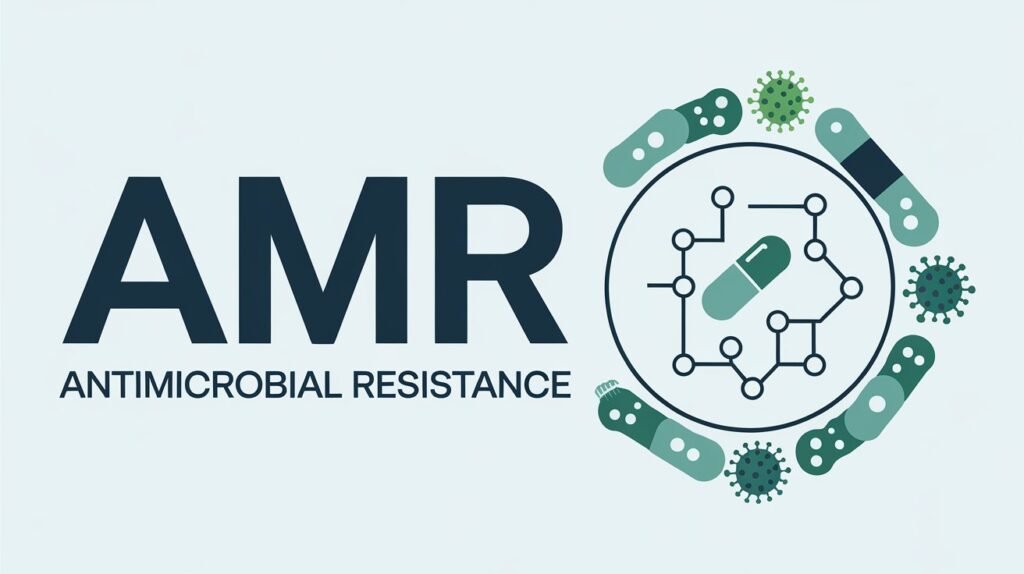Antimicrobial Resistance (AMR) is no longer a distant concern—it is a looming health crisis that is growing louder and deadlier with each passing year. Health experts, researchers, and global organizations have repeatedly raised the alarm over the rising resistance of microbes—bacteria, viruses, fungi, and parasites—to the drugs designed to kill them.
What was once considered a triumph of modern medicine is now facing erosion. Antibiotics, antifungals, antivirals, and antiparasitic drugs are increasingly becoming ineffective, jeopardizing lives and threatening the gains of decades-long medical advancements.

🔷 The Growing Scope of the Problem
1. What Is Antimicrobial Resistance?
Antimicrobial Resistance occurs when microbes evolve and adapt to survive exposure to antimicrobial agents. These organisms continue to grow, despite the use of medicine meant to stop them. This renders standard treatments ineffective, leading to prolonged illnesses, higher medical costs, and increased mortality.
2. The Alarming Numbers
- In India alone, AMR is estimated to contribute to over 50,000 neonatal deaths every year.
- According to the World Health Organization (WHO), at least 1.27 million deaths globally in 2019 were directly attributed to AMR.
- The number could rise to 10 million annual deaths by 2050 if urgent actions are not taken.
🔷 Key Causes Behind the Surge
1. Overuse and Misuse of Antibiotics
- Self-medication without prescriptions.
- Over-prescription by healthcare providers.
- Use of antibiotics for viral infections like the common cold.
2. Agricultural and Livestock Practices
- Widespread use of antibiotics in farming to promote animal growth.
- AMR genes passed from animals to humans through the food chain.
3. Lack of Access to Quality Healthcare
- Inadequate regulation and surveillance systems in developing nations.
- Poor sanitation and hygiene, facilitating rapid microbial transmission.
🔷 Impact on Modern Medicine
1. Routine Surgeries Becoming Risky
Without effective antibiotics, common procedures like C-section deliveries, cancer chemotherapy, organ transplants, and even dental surgeries can become life-threatening.
2. Increased Hospital Stays and Costs
Patients infected with drug-resistant strains often require longer hospitalization, second-line treatments, and intensive care, placing immense burden on already stretched healthcare systems.
🔷 The Indian Perspective: A Country on the Edge
India, known for its pharmaceutical industry, ironically stands at a critical point in the AMR crisis.
Why India Is at Higher Risk:
- Easy over-the-counter access to antibiotics.
- Lack of robust antibiotic stewardship programs.
- Inadequate waste management of pharmaceutical and hospital effluents.
Government Response So Far:
- The National Action Plan on AMR (2017–2021) laid the groundwork for AMR surveillance.
- Collaboration with global agencies like WHO and the Food and Agriculture Organization (FAO) for awareness and response strategies.

🔷 Global Efforts and Challenges
1. WHO’s Global Action Plan
- Surveillance of AMR patterns.
- Investment in new antimicrobial development.
- Strengthening healthcare systems globally.
2. Challenges Hindering Progress
- Limited innovation in new antibiotics.
- Low financial incentives for pharma companies.
- Weak international regulations and enforcement.
🔷 The Way Forward: Solutions and Recommendations
1. Strengthen Surveillance and Regulation
- Mandatory reporting of resistant infections.
- Strict regulation on antibiotic sales and usage.
2. Promote Rational Use of Antibiotics
- Public awareness campaigns.
- Antimicrobial stewardship programs in hospitals.
3. Invest in Research and Innovation
- Incentivize R&D for novel antibiotics and alternatives.
- Support development of rapid diagnostic tools.
4. Enhance Global Collaboration
- Share AMR data across borders.
- Joint initiatives between governments, scientists, and industries.
🔷 Public Responsibility: What Can You Do?
- Do not self-medicate. Only take antibiotics prescribed by a certified doctor.
- Complete your full dosage. Stopping treatment mid-way helps resistant strains survive.
- Practice hygiene. Washing hands, maintaining sanitation, and proper food handling can prevent infection spread.
🔷 Expert Opinion: A Wake-Up Call
Dr. Rajesh Bansal, an infectious disease specialist from PGIMER Chandigarh, emphasized,
“Antimicrobial Resistance is not just a medical issue; it’s a social, economic, and environmental concern. If ignored, it could push us into a post-antibiotic era where even a minor injury becomes fatal.”
🔷 Conclusion: Time Is Running Out
Antimicrobial Resistance is a ticking time bomb—unseen but devastating. While science and policy can help stem the tide, global and individual action is crucial.
This crisis is not just about the future; it’s happening now. The question is: Will we act in time, or will we allow history to repeat itself with microbes outsmarting medicine once again?
📝 Stay informed and proactive. For more updates on global health, visit our health news section daily.